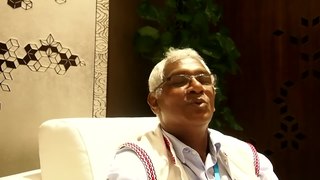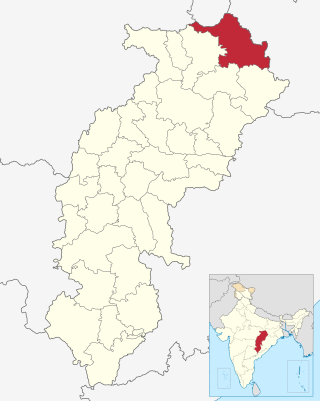Related Research Articles

The Munda languages are a group of closely related languages spoken by about nine million people in India and Bangladesh. Historically, they have been called the Kolarian languages. They constitute a branch of the Austroasiatic language family, which means they are more distantly related to languages such as the Mon and Khmer languages, to Vietnamese, as well as to minority languages in Thailand and Laos and the minority Mangic languages of South China. Bhumij, Ho, Mundari, and Santali are notable Munda languages.
Ho is a Munda language of the Austroasiatic language family spoken primarily in India by about 1.04 million people per the 2001 census. Ho is a tribal language. It is spoken by the Ho, Munda, Kolha and Kol tribal communities of Odisha, Jharkhand, Bihar, Chhattisgarh, West Bengal, Assam and is written with the Warang Citi script. Devanagari, Latin script, Odia script and Telugu script are sometimes used, although native speakers are said to prefer a Ho script. The latter script was invented by Ott Guru Kol Lako Bodra.

Kurukh, also Kurux, Oraon or Uranw, is a Dravidian language spoken by the Kurukh (Oraon) and Kisan people of East India. It is spoken by about two million people in the Indian states of Jharkhand, Chhattisgarh, Odisha, West Bengal, Assam, Bihar and Tripura, as well as by 65,000 in northern Bangladesh, 28,600 of a dialect called Uranw in Nepal and about 5,000 in Bhutan. Some Kurukh speakers are in Andaman and Nicobar Islands. It is most closely related to the Malto language. It is marked as being in a "vulnerable" state in UNESCO's list of endangered languages. The Kisan dialect has 206,100 speakers as of 2011.

Jharsuguda is a district in Odisha, India with Jharsuguda town as its headquarters. This region is rich in coal and other mineral reserves. Of late, many small and medium scale iron and steel units have been set up in the vicinity of Jharsuguda town, giving impetus to the industrial growth of the district.

The Kharia language is a Munda language of the Austroasiatic language family, that is primarily spoken by the Kharia people of eastern India.

Jashpur District is a district of the central Indian state of Chhattisgarh bordering Jharkhand and Odisha. Jashpur Nagar is the administrative headquarters of the district. The district was formerly a princely state before Indpendence. Highly mountainous and forested, Jashpur is known for its natural environment.

Raigarh is a city in northern Chhattisgarh known as the 'Cultural capital of Chhattisgarh', Raigarh is famous for its dance form “Kathak” and classical music, Raigarh is also known as Sanskardhani.

Surguja district is a district of the Indian state of Chhattisgarh. The district is one of the oldest districts of Chhattisgarh. The headquarters of the district is Ambikapur.

Korku is an Austroasiatic language spoken by the Korku tribe of central India, in the states of Madhya Pradesh and Maharashtra. It is isolated in the midst of the Gondi people, who are Dravidian, while its closest relatives are in eastern India. It is the westernmost Austroasiatic language.
Kodaku people are an indigenous people who live in India. They live in the hills and forest of Chhotanagpur, the bordering area of Chhattisgarh, Jharkhand and Uttar Pradesh. Their mother tongue, a Munda language, is also called Kodaku. Some Kodaku people speak Korwa as their mother tongue. They also speak Sadri, Chhattisgarhi, or Kurukh as their second language. The Kodaku people are mainly concentrated in the northeastern area of Surguja district in Chhattishgarh, southern parts of Palamau, Gadhwa in Jharkhand and the southeastern region of Sonabhadra district of Uttar Pradesh. Kodaku people are now included in Scheduled Tribes by government of India.

The Korwa people are a Munda, a Scheduled Tribe ethnic group of India. They live mainly on the border between Chhattisgarh and Jharkhand. A small number of Korwa are also found in the Mirzapur district of Uttar Pradesh.

Nagpuri is an Indo-Aryan language spoken in the Indian states of Jharkhand, Chhattisgarh, Odisha and Bihar. It is primarily spoken in the west and central Chota Nagpur plateau region. It is sometimes considered a dialect of Bhojpuri.
Mundari (Munɖari) is a Munda language of the Austroasiatic language family spoken by the Munda tribes in eastern Indian states of Jharkhand, Odisha and West Bengal. It is closely related to Santali. Mundari Bani, a script specifically to write Mundari, was invented by Rohidas Singh Nag. It has also been written in the Devanagari, Odia, Bengali, and Latin writing systems.
Asuri is an Austroasiatic language spoken by the Asur people, part of the Munda branch. Asuri has many Dravidian loanwords due to contact with Kurukh.
Most of the languages of Bihar, the third most populous state of India, belong to the Bihari subgroup of the Indo-Aryan family. Chief among them are Bhojpuri, spoken in the west of the state, Maithili in the north, and Magahi in the south. Of these, only Maithili has official recognition under the Eighth Schedule to the Constitution of India. The official language of Bihar is Hindi, with Urdu serving as a second official language in 15 districts.
Lodhi is a Munda language, or dialect cluster, of India. Kharia Thar is only spoken by one quarter of ethnic Lodhi in Orissa. However, while admitting that Lodhi is related to Sora, a Munda language, Ethnologue classifies it as Indic (Bengali–Assamese), and it is considered a variety of Hindi in the Indian census. It may be that there are both Munda and Indic varieties subsumed under the name Lodhi.
Turi is an endangered Munda language of India that is closely related to Mundari. It is spoken by only half a percent of ethnic Turi, the rest having shifted to Sadri in Jharkhand, Mundari in West Bengal, and Odia in Odisha. The Turi are classified as a Scheduled Caste in Jharkhand.

Balrampur-Ramanujganj district is a district in the Indian state of Chhattisgarh. It came into existence on 17 January 2012 and was formerly part of Surguja district. Balrampur-Ramanujganj district is the northernmost district of Chhattisgarh. It's seat is Balrampur.

Surguja State, was one of the main princely states of Central India during the period of the British Raj, even though it was not entitled to any gun salute. Formerly it was placed under the Central India Agency, but in 1905 it was transferred to the Eastern States Agency.
Surgujia is an Indo-Aryan language variety spoken in Chhattisgarh. It belongs to the Eastern Hindi group. It is considered a dialect of Chattisgarhi language
References
- ↑ "Statement 1: Abstract of speakers' strength of languages and mother tongues - 2011". www.censusindia.gov.in. Office of the Registrar General & Census Commissioner, India. Retrieved 2018-07-07.
- Anderson, Gregory D.S (ed). 2008. The Munda languages. Routledge Language Family Series 3.New York: Routledge. ISBN 0-415-32890-X.
- Bahl, Kali Charan. 1962. Korwa Lexicon. m.s., 148pp.
- Singh, Bageshwar and Ajit K. Danda. 1986. The Kodaku of Surguja. Calcutta: Anthropological Survey of India.